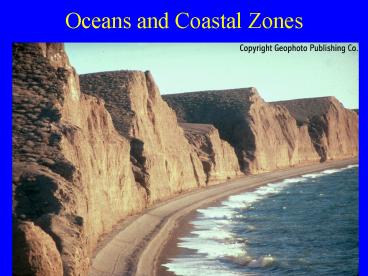Oceans and Coastal Zones - PowerPoint PPT Presentation
1 / 34
Title:
Oceans and Coastal Zones
Description:
circulates through the ocean in currents, tides, and wave systems ... Mangroves are a tropical tree that grows in shallow salt and brackish water. ... – PowerPoint PPT presentation
Number of Views:65
Avg rating:3.0/5.0
Title: Oceans and Coastal Zones
1
Oceans and Coastal Zones
2
The Ocean Ecosystem
- Approximately 97 of the worlds surface water is
salt water - circulates through the ocean in currents, tides,
and wave systems - southern Hemisphere is dominated by oceans
- northern Hemisphere is dominated by land masses
3
Regions of the Ocean
- The ocean ecosystem consists of a number of
separate but interrelated ecosystems, each with
their own physical and biological
characteristics - continental shelves
- continental slope
- ocean floor
4
Where are the Oceans?
- While the ocean can be considered one enormous
ecosystem -- it is not a uniform environment - Better to perceive the ocean as a set of as set
of interconnected ecosystems. - Four main basins can be distinguished
- Pacific
- Atlantic
- Indian
- Arctic
Map of the worlds oceans, with red dots
corresponding to dead zones
5
Major US drainages
The Mississippi River Watershed is highlighted in
yellow.
6
Major US drainages
Ohio River
Sub-watersheds of the Mississippi River
7
Select Watersheds in Indiana and Illinois
White River Watershed
8
(No Transcript)
9
Ocean Circulation
- This difference between the hemispheres is
important in determining the distribution of
weather and climate patterns around the world.
10
What factors drive ocean circulation?
- Temperature
- Salinity
- Atmospheric Circulation
11
Ocean Environments
12
The Coastal Zone
13
Importance of the Coastal Zone
- majority of the Earths population lives within
100 km of the coast - means that a large portion of the Earths
population is at risk from large storms generated
over the ocean - Also means that the ocean, and particularly the
continental shelves, are susceptible to human
impact
14
Health of the Oceans
- The health of the world's ocean is imperiled
- The symptoms can be seen everywhere
- increasing occurrences of toxic algal blooms
- declining fish populations
- widespread bleaching of coral reefs
- continuing losses of wetlands
15
- Perhaps more troubling still are less visible
problems, such as pollutants that pour into the
seas from rivers and streams and runoff from
urban and agricultural areas.
16
Coastal Processes
17
- Coastal zone represents the transition zone
between land and sea, as such it is dynamic,
constantly changing environment. - Coastal zones encompass a wide variety of
environments - mangroves swamps
- estuaries
- salt marshes
- beaches
- coral reefs
18
Mangrove Swamps
Mangroves are a tropical tree that grows in
shallow salt and brackish water. The trunks are
above high tide, held up by sturdy roots. The
root systems host a diverse ecology where many
young fish and young invertebrates grow.
19
Estuaries
- A partially enclosed body of water formed where
freshwater from rivers and streams flows into the
ocean, mixing with the salty sea water. - Often known as bays, lagoons, harbors, inlets, or
sounds. - Estuarine environments are among the most
productive on Earth. - http//earth1.epa.gov/nep/sheds.htm
20
Secondary coasts reefs
Coral Reefs
Reefs only form in warm, tropical seas, but in
those environments they form important
shorelines. These images are of atolls in the
western Pacific Ocean.
21
Coastal Erosion
- Erosion and its effects are often seasonal
- Summer
- waves low, long wavelength
- sand is transported shoreward, settles out
- beach sands, sea cliffs protected by low energy
of system
22
Coastal Erosion
- Winter
- waves higher, shorter wavelength
- sand eroded from beaches, kept in suspension and
transported offshore - beach reduced, may be completely removed
- waves attack sea cliffs
- Significant changes can occur to the beach during
short intense periods (storms) followed by longer
periods of little change
23
Factors affecting erosion
- oceanic conditions
- resistance of coastal materials
- alteration of normal drainage
- growth of vegetation
- vibration and load effects above cliff
24
Rates of Coastal Retreat
- California coast
- rate depends on nature of coastal materials
- resistant rocks 0 - 1 cm/yr
- nonresistant rocks 30 cm/yr
- at Ano Nuevo near San Francisco, average rate of
retreat over the past 300 years is estimated at
2.7 m/yr
25
(No Transcript)
26
(No Transcript)
27
Stabilization and Control of Coastlines
- rip-rap
- large blocks of resistant rock, etc., placed at
the base of cliff to absorb wave energy - rip-rap must be continuous or waves will erode
cliff around, and ultimately behind the rip-rap - commonly utilized by individual property owners
- can be expensive
28
(No Transcript)
29
Stabilization and Control of Coastlines
- seawalls
- concrete structures built along coast, same
principle as rip-rap - usually significant erosion just seaward of the
wall due to reflected wave energy -- seawall may
topple over if erosion is allowed to continue
Galveston seawall
30
Stabilization and Control of Coastlines
- groins, jetties
- built perpendicular to coastline to stabilize or
built a beach by trapping sediment being
transported by longshore current - major problem is erosion down the coastline
Pacific Palisades , California
31
Stabilization and Control of Coastlines
- breakwater
- structures built offshore to protect the
coastline from approaching waves
Terrebonne Parish, Louisiana
Wessex Coast, Southern England
32
(No Transcript)
33
- The health of the world's ocean is imperiled
- The symptoms can be seen everywhere
- increasing occurrences of toxic algal blooms
- declining fish populations
- widespread bleaching of coral reefs
- continuing losses of wetlands
34
- Perhaps more troubling still are less visible
problems, such as pollutants that pour into the
seas from rivers and streams and runoff from
urban and agricultural areas.































